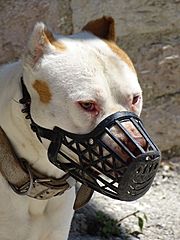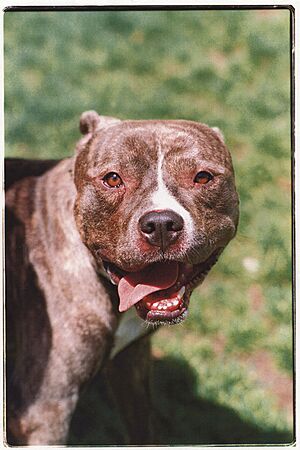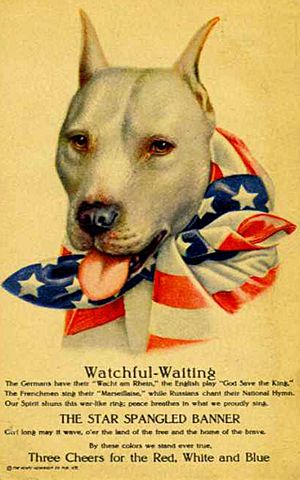Pit bull facts for kids
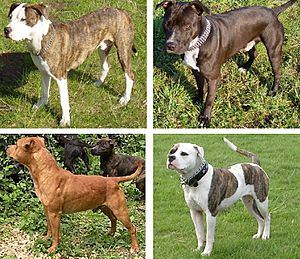
A selection of dog breeds sometimes classified as pit bull types. Clockwise from top left: American Pit Bull Terrier, American Staffordshire Terrier, American Bully, Staffordshire Bull Terrier.
|
|
| Origin | United States |
|---|---|
| Domestic dog (Canis lupus familiaris) | |
A Pit bull is a general name used in the United States for a certain type of dog. These dogs are thought to have come from bull and terriers. In other countries, like the United Kingdom, "pit bull" often means the American Pit Bull Terrier breed specifically. In the U.S., the term "pit bull" usually includes breeds like the American Pit Bull Terrier, American Staffordshire Terrier, American Bully, Staffordshire Bull Terrier, and sometimes the American Bulldog. It also includes mixed-breed dogs that look similar to these.
Pit bull-type dogs have a debated reputation as pets. This is partly because of their past in dog fighting. Also, there have been many news stories about attacks, and these dogs are known for holding on tightly when they bite. People often discuss whether a pit bull's behavior is due to how they are raised by their owners or if it's just part of their natural qualities. Many groups work to defend pit bulls. Some studies say these dogs are not more dangerous than others, while others show they are involved in many bite incidents. Some insurance companies do not cover pit bulls because of the number of bite incidents linked to them.
Even though it's against the law, pit bull-type dogs are still used in illegal dogfighting in the United States. Many countries and areas have rules about owning pit bull-type dogs. There are also groups that spend a lot of money to promote pit bulls as good family pets. They also work against laws that control who can own these dogs.
Contents
The History of Pit Bulls
The name "pit bull" has been used since the early 1900s. All dogs now called pit bulls are believed to come from the British bull and terrier. These dogs were first brought to North America in the 1870s. The bull-and-terrier was developed in the United Kingdom in the early 1800s. They were bred for blood sports like dog fighting and rat baiting. These dogs were a mix of the strong Old English Bulldog and the quick Black and Tan Terrier.
The Old English Bulldog was bred for fighting bears and bulls. But people found that lighter, faster dogs were better for dogfighting. So, they mixed the Bulldog with local terriers. This created a quicker dog that still had the Bulldog's courage.
Just like in the United Kingdom, dog fighting became popular in 19th-century America. Bull-and-terriers were brought to the U.S. for this sport. In the United States, organized dog fights have been slowly made illegal since 1874. Federal laws made animal fighting a crime in 2007.
In the 1890s, breeders of American pit bull-type dogs wanted their dogs to be recognized by the American Kennel Club. But the club said no because these dogs were linked to dogfighting. After this, in 1898, breeders of American Pit Bull Terriers started their own club, the United Kennel Club. This club registered breeds and also organized dogfights.
In the 1930s, the American Kennel Club wanted to recognize a unique American dog breed. They had over 30 years of records for these dogs. Their solution was to recognize Pit Bull Terriers under a different name. They also made sure these dogs were not used in organized fights. So, in 1935, the American Kennel Club recognized Pit Bull Terriers as Staffordshire Terriers.
The name "Staffordshire Bull Terrier" was first used in Britain in 1930. Organized dog fighting was mostly stopped in the United Kingdom by a law in 1911. But people who loved the bull-and-terrier type kept breeding them. They mostly did this in England's Black Country. In the early 1930s, efforts were made in England to get these dogs recognized by The Kennel Club. This happened successfully in 1935. To avoid confusion with the British breed, the American Kennel Club changed the name of their American breed to the American Staffordshire Terrier in 1972.
Even though it's illegal, dog fights using pit bull-type dogs are still common in the United States. In the 1990s, it was thought that 1,500 dogs died each year in organized fights. By the mid-2000s, over 40,000 people were believed to be involved in this illegal sport. Pit bull-type dogs are also used by criminal groups to scare and attack people. They have become a symbol of power in American gang culture. On the other hand, pit bull-type dogs have been used by U.S. Customs and Border Protection as drug detection dogs.
Some animal rights groups are spending a lot of money to try to change how people see pit bulls. They want to show them as family dogs. Groups like the San Francisco Society for the Prevention of Cruelty to Animals and the New York City Center for Animal Care and Control have tried to rename the type. But these efforts have not been successful.
How to Identify Pit Bulls
It can be hard to tell if a mixed-breed dog is a pit bull just by looking. Studies show that people who work with dogs, like those in rescue or adoption, often identify mixed-breed dogs as pit bulls if they have certain looks. These include a square-shaped head or a strong, bulky body. However, courts have said that a regular dog owner can usually identify a pit bull.
Understanding Dog Behavior and Safety
Some studies have looked at dog bites and fatalities. A 2000 review found that Rottweilers and pit bull-type dogs were involved in 67% of human dog bite-related deaths in the U.S. between 1997 and 1998. This suggests there might be a problem with these breeds in terms of serious incidents. However, it's important to know that studies based on news reports can have errors. Some attacks might not be reported, or the dog's breed might be wrong. After 2000, the CDC stopped tracking dog bite data this way. They said it was too hard to make good sense of the information.
More recent studies from hospitals show that pit bulls cause more severe injuries than other breeds. One review from 2020 found that pit bull-type dogs were second only to German Shepherds for bites needing hospital care. The number of bites from pit bulls increased over time, while bites from German Shepherds decreased.
The American Veterinary Medical Association (AVMA) says that a dog's breed alone is not a good way to predict if it will bite. Some studies don't show pit bulls as being more dangerous. Others say they are more likely to attack without being provoked. Pit bull-type dogs are often linked to very serious injuries or deaths. But some suggest this might be because they are popular dogs. The CDC, AVMA, and American Society for the Prevention of Cruelty to Animals (ASPCA) do not encourage tracking bite statistics by breed anymore.
Pit bulls were originally bred for bull baiting and dog fighting. Because of this history, they can sometimes show strong aggression towards other animals. This contributes to how people view the breed. In fights with other dogs, pit bulls, German Shepherds, Great Danes, and Rottweilers were often the ones to start the fight. More than 20% of Akitas, Jack Russell Terriers, and pit bulls studied showed serious aggression towards other dogs. It's debated whether there's a direct link between a dog's breed and aggression towards humans. It's hard to classify dog attacks by specific breed after they happen.
Pit bulls are known for their strong grip and not letting go of a bite, even if they are in pain. There's a myth that pit bulls have "locking jaws," but this is not true. Their jaws don't have a special locking part. Instead, their refusal to let go is a behavior. Like other terriers and hunting dogs, pit bull-type dogs can bite, hold, and shake. They also have wide skulls, strong face muscles, and powerful jaws. Some research suggests that pit bull bites are serious because they tend to bite deeply and grind their teeth into tissue. One way to make a dog release its hold is to break an ammonia ampule near its nose.
Pit Bulls in Animal Shelters
Many people don't want pit bulls, which makes it harder for animal shelters to find them homes. Some shelter workers might even change the breed label of pit bulls to help them get adopted. This also helps avoid putting them down in places where they are banned. Animal advocates suggest that shelters stop labeling breeds to help more pit bulls get adopted. Pit bulls also have a higher rate of adoptions that don't work out. They are more likely to be returned to a shelter many times and eventually put down. It's not known if this is because of their behavior or because of how people view them. Generally, the main reasons shelter dog adoptions fail are behavior problems or not getting along with other pets in the home.
Laws About Dog Breeds
Many news reports about pit bull attacks have led to laws about specific dog breeds (BSL). These laws have been put in place in different areas. In some cases, cities have even changed their minds and removed these bans.
Laws that target specific breeds have largely been found not to work well in reducing dog attacks. Research shows that people who work in dog adoption resist these laws. They try to be very careful before labeling a dog as a pit bull. Veterinarians also often object to these laws.
Many places that have rules about pit bulls include the modern American Pit Bull Terrier, American Staffordshire Terrier, Staffordshire Bull Terrier, and any other dog that looks like them. This includes places like Ontario, Canada, and Miami, USA. Denver, Colorado, removed its long-standing ban on the breed in 2021 after people voted to end it.
However, a few places, like Singapore, also include the modern American Bulldog as a "pit bull-type dog." In the United Kingdom, a pit bull means an American Pit Bull Terrier.
Courts in the United States and Canada have said that experts can identify breeds using official breed standards. This is enough to enforce breed-specific laws.
Debates often focus on whether a dog's aggressive behavior comes from bad ownership or is natural for the breed.
In England and Wales, the Dangerous Dogs Act of 1991 makes it illegal to own American Pit Bull Terriers, along with three other breeds. This law also bans breeding, selling, and trading these dogs. Similar laws exist in Australia. In Ireland, American Pit Bull Terriers must be walked by someone at least 16 years old. They must be on a short, strong leash, wear a muzzle, and have a collar with their owner's name and address in public. In Germany, it is illegal to bring pit bulls into the country.
Rules for Owners and Travel
Insurance for Dog Owners
Dog owners in the United States can be held responsible for injuries their dogs cause. Usually, owners are responsible if they were careless with their dog. Or if they knew their dog might cause harm. Some local laws also make owners responsible for all damage caused by their dog, no matter what. Homeowners and renters insurance usually covers dog bite injuries. But some insurance companies limit their coverage for certain dog breeds. They might refuse to cover bites, charge more, or require owners to take special training. They might also require dogs to wear muzzles or be kept in certain enclosures. Some companies even refuse to insure homes with specific dog breeds.
Owners of rental properties can also be held responsible if they knew an aggressive dog lived there and did nothing to keep others safe. Because of this, many rental places do not allow pit bull-type dogs or other breeds if their insurance won't cover damage from those dogs. The dog breeds most often not covered by insurance companies include pit bull-type dogs, Rottweilers, German Shepherd Dogs, Doberman Pinschers, Akitas (Akita Inu and American Akitas), and Chow Chows.
In 2013, Farmers Insurance told its customers in California that it would no longer cover bites from pit bulls, Rottweilers, and wolf-dog hybrids. A spokesperson for Farmers said these breeds were involved in more than a quarter of their dog bite claims.
Flying with Dogs
Some airlines have rules about flying with certain dog breeds. This includes dogs with short noses (brachycephalic breeds) and strong-jawed breeds. This is often due to health or safety concerns. For example, some airlines do not allow pit bull-type dogs in the cabin or as checked luggage. They might also make owners fly with these dogs at their own risk.
| Airline | Reason | Details |
|---|---|---|
| Air France | Safety | Certain "attack dogs" are not allowed to fly. These include dogs that look like Staffordshire Bull Terriers or American Staffordshire Terriers (pit bulls), Mastiffs, and Tosas. |
| Alaska Airlines | Health | Dog breeds like Staffordshire Bull Terriers, American Staffordshire Terriers, and American Pit Bull Terriers fly at the owner's risk. This means no extra payment if the dog gets hurt or dies during the flight. The airline might also refuse the dog if the weather is too hot or cold. |
| American Airlines | Health | American Airlines will not accept short-nosed dogs as checked luggage. |
| United Airlines | Health | United Airlines does not accept reservations for short-nosed dogs and cats, or strong-jawed dog breeds. This is because of higher health risks for these animals during travel. |
| Delta Air Lines | Safety | Delta Air Lines has said that untrained pit bull-type dogs pretending to be service or support animals are a possible safety risk. |
Famous Pit Bulls
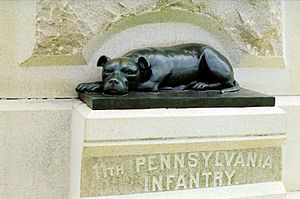
- Sallie Ann Jarrett was the mascot of the 11th Pennsylvania Infantry Regiment during the American Civil War.
- Nipper was a mixed-breed dog, sometimes called a pit bull. He is the dog in Francis Barraud's 1898 painting His Master's Voice.
- Sergeant Stubby, a dog whose breed is debated, served in the 102nd Infantry during World War I. He has been called a pit bull.
- Pete the Pup, a character from The Little Rascals movies, was played by pit bull-type dogs.
- In the 21st century, famous pit bulls include Star. She was shot by police while protecting her owner, and the video became very popular. Also, Daddy was dog trainer Cesar Millan's helper dog. He was known for being calm and good with other dogs.
Pit Bulls as a Symbol
Owning dogs like pit bulls and rottweilers can be seen as a symbol of power. Pit bulls have been important cultural symbols in "urban ghettos" and are part of hip hop culture. The Anti-Defamation League lists the pit bull under "General Hate Symbols."
Pit bulls have appeared in American World War I propaganda.
Pit bulls have also been used in logos for companies like Brown Shoe Company and Lagunitas Brewing Company. The dog Nipper, mentioned earlier, appeared in the logos of RCA and HMV. The White supremacist group Keystone State Skinheads has used a pit bull as their logo.
In 2005, two American lawyers used a pit bull logo and the phone number 1-800-PIT-BULL in a TV ad. They wanted to show they were "especially fierce litigators." The Supreme Court of Florida ruled that this was against the Florida Bar's advertising rules.
See also
 In Spanish: Pit bull terrier americano para niños
In Spanish: Pit bull terrier americano para niños



